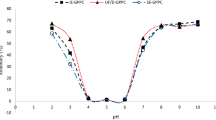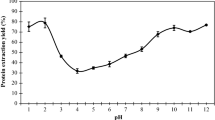Abstract
The effect of membrane processing on the functional properties, structural changes, subunit profile and sensory attributes of the groundnut protein concentrate was investigated. Results indicated an increase in the nitrogen solubility and foaming capacity of the protein concentrate over all pH ranges (2–10) compared to acid precipitated protein isolate. Protein concentrate showed higher emulsion stability index compared to control flour and protein isolate. Surface hydrophobicity studies showed that protein concentrate is less hydrophobic (~29 units) compared to acid precipitated protein isolate (~34 units). SDS-PAGE profile of the samples showed similarity in the subunit pattern of groundnut protein concentrate and groundnut flour. Sensory analysis suggested membrane filtration could reduce the groundnut-like nutty and beany notes of the concentrate. Thus, membrane technology could give a protein concentrate with improved functionality and sensory characteristics which will have potential application in the development of food product formulations.





Similar content being viewed by others

References
Adebiyi AP, Adebiyi AO, Ogawa T, Muramoto K (2007) Preparation and characterization of high-quality rice bran proteins. J Sci Food Agric 87:1219–1227. doi:10.1002/jsfa.2819
Adebowale YA, Schwarzenbolz U, Henle T (2011) Protein Isolates from Bambara Groundnut (Voandzeia Subterranean L.): Chemical Characterization and Functional Properties. Int J Food Prop 14:758–775. doi:10.1080/10942910903420743
AOAC (2005) International Methods 925.10, In official methods of analysis of association of official analytical chemists, 18th ed. Washington
Arrese EL, Sorgentini DA, Wagner JR, Anon MC (1991) Electrophoretic, solubility and functional properties of commercial soy protein isolates. J Agric Food Chem 39:1029–1032. doi:10.1021/jf00006a004
Booma K, Prakash V (1990) Functional properties of the flour and the major protein fraction from sesame seed, sunflower seed and safflower seed. Acta Aliment 19:163–176
Damodaran S (1996) Amino acids, peptides and proteins. Food Chem. third Ed. CRC Press, pp 321–329
Dravnieks A (1985) Atlas of odor character profiles by ASTM Data Series DS 61. American Society for Testing and Materials. PA, Philadelphia
FAO (2009) Perspectivas Alimentarias – análisis de los mercados mundiales.
González-Pérez S, Vereijken JM, van Koningsveld GA, et al. (2005) Formation and stability of foams made with sunflower (Helianthus annuus) proteins. J Agric Food Chem 53:6469–6476. doi:10.1021/jf0501793
Hayakawa SS, Nakai S (1985) Relationships of Hydrophobicity and Net Charge to the Solubility of Milk and Soy Proteins. J Food Eng 50:486–491. doi:10.1111/j.1365-2621.1985.tb13433.x
IV EC, Wolf MB (1996) Sensory testing methods, 2nd edn. ASTM International, pp. 54–72
Kuehler CA, Stine CM (1974) Effect of enzymatic hydrolysis on some functional properties of whey protein. J Food Sci 39:379–382. doi:10.1111/j.1365-2621.1974.tb02899.x
Laemmli UK (1970) Cleavage of structural proteins during the assembly of the head of bacteriophage T4. Nature 227:680–685. doi:10.1038/227680a0
Lawal OS, Adebowale KO, Adebowale YA (2007) Functional properties of native and chemically modified protein concentrates from bambarra groundnut. Food Res Int 40:1003–1011. doi:10.1016/j.foodres.2007.05.011
Martin A, Grolle K, Bos M, et al. (2002) Network Forming Properties of Various Proteins Adsorbed at the Air/Water Interface in Relation to Foam Stability. J Colloid Interface Sci 254:175–183. doi:10.1006/jcis.2002.8592
Monteiro PV, Prakash V (1994) Functional properties of homogeneous protein fractions from peanut (Arachis hypogaea L.). J Agric Food Chem 42:274–278. doi:10.1021/jf00038a009
Pearce KN, Kinsella JE (1978) Emulsifying properties of proteins: evaluation of a turbidimetric technique. J Agric Food Chem 26:716–723. doi:10.1021/jf60217a041
Radha C, Prakash V (2010) Structural and Functional Properties of Heat-processed Soybean Flour: Effect of Proteolytic Modification. Food Sci Technol Int 15:453–463. doi:10.1177/1082013209350347
Radha C, Ramesh Kumar P, Prakash V (2008) Enzymatic modification as a tool to improve the functional properties of heat-processed soy flour. J Sci Food Agric 88:336–343. doi:10.1002/jsfa.3094
Rao A, Shallo HE, Ericson AP, Thomas RL (2002) Characterization of soy protein concentrate produced by membrane ultrafiltration. J Food Sci 67:1412–1418
Sosulski F, Fleming SE (1977) Chemical, functional, and nutritional properties of sunflower protein products. J Am Oil Chem Soc 54:A100–A104. doi:10.1007/BF02912382
Stone H, Sidel JL (1998) Quantitative descriptive analysis: developments, applications and the future. Food Technol.
Surówka K, Fik M (1994) Studies on the recovery of proteinaceous substances from chicken heads: II—Application of pepsin to the production of protein hydrolysate. J Sci Food Agric 65:289–296. doi:10.1002/jsfa.2740650305
Tomotake H, Shimaoka I, Kayashita J, et al. (2002) Physicochemical and functional properties of buckwheat protein product. J Agric Food Chem 50:2125–2129
Wu H, Wang Q, Ma T, Ren J (2009) Comparative studies on the functional properties of various protein concentrate preparations of peanut protein. Food Res Int 42:343–348
Zhang K, Li Y, Ren Y (2007) Research on the phosphorylation of soy protein isolate with sodium tripoly phosphate. J Food Eng 79:1233–1237. doi:10.1016/j.jfoodeng.2006.04.009
Acknowledgments
The authors are grateful to the Director, CSIR–CFTRI, Mysore for the encouragement.
Author information
Authors and Affiliations
Corresponding author
Additional information
Research Highlights • The functionality of groundnut protein concentrate was investigated
• Membrane technology was used for concentrate preparation
• Concentrate showed changes in structure, subunit profile and sensory attributes
• Functionality of concentrate was superior compared to acid precipitated isolate
Rights and permissions
About this article
Cite this article
Jain, A., Prakash, M. & Radha, C. Extraction and evaluation of functional properties of groundnut protein concentrate. J Food Sci Technol 52, 6655–6662 (2015). https://doi.org/10.1007/s13197-015-1758-7
Revised:
Accepted:
Published:
Issue Date:
DOI: https://doi.org/10.1007/s13197-015-1758-7



